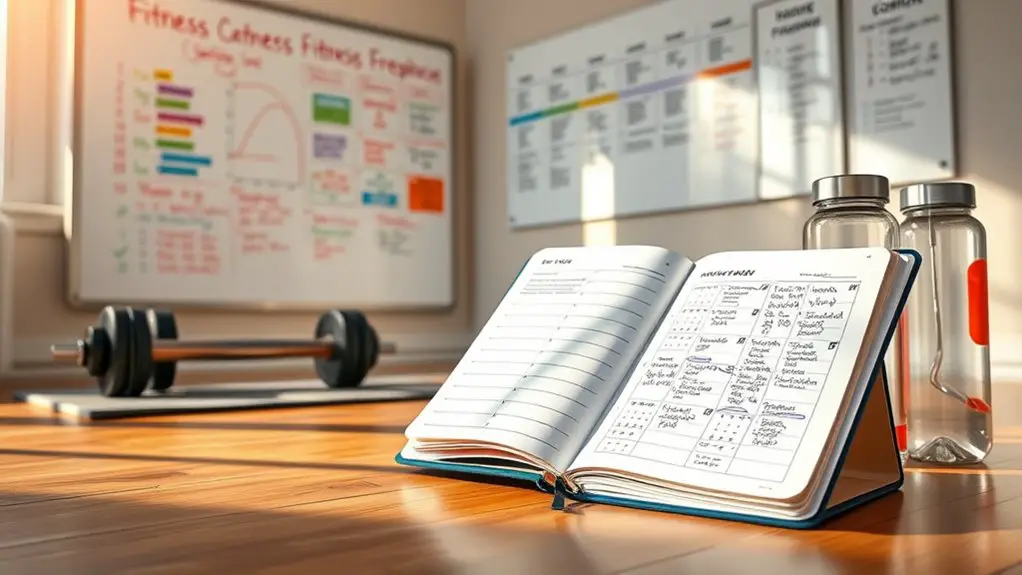How to Design Your Own Workout Program

To design your own workout program, start by evaluating your fitness goals, like weight loss or muscle building. Next, determine your current fitness level with simple tests for endurance, strength, and flexibility. Choose a mix of strength training and cardio exercises that you enjoy. Plan a realistic workout schedule that allows for flexibility and includes rest days. As you progress, track your improvements and make adjustments as needed. There’s more to explore to create the perfect program for you.
Assess Your Fitness Goals

How do you know where to start with your workout program? The first step is evaluating your fitness goals. Think about what you want to achieve—whether it’s losing weight, building muscle, or improving endurance. This clarity helps you set specific, measurable goals that keep you focused.
Utilize effective goal-setting techniques, like the SMART method: make your goals Specific, Measurable, Achievable, Relevant, and Time-bound. Once you’ve defined your goals, think about motivation techniques to help you stay on track. Consider finding a workout buddy, tracking your progress, or rewarding yourself for milestones reached.
Determine Your Current Fitness Level
Understanding your current fitness level is essential for creating an effective workout program. To safely progress, you should start with fitness assessments that evaluate your endurance, flexibility, and strength. These assessments help you identify personal strength benchmarks, ensuring your program aligns with your capabilities.
Here’s a simple table to guide you through common fitness assessments:
| Assessment Type | Purpose | Example Exercise |
|---|---|---|
| Endurance | Test stamina | 1-mile run |
| Flexibility | Measure range of motion | Sit and reach test |
| Upper Body Strength | Assess strength | Push-up test |
| Lower Body Strength | Evaluate leg power | Squat test |
| Core Stability | Check balance | Plank hold |
Choose the Right Types of Exercises

Choosing the right types of exercises is essential for achieving your fitness goals, as it guarantees your program is both effective and enjoyable. You should aim to include a mix of strength training and cardio exercises tailored to your preferences and fitness level. Strength training helps build muscle and boost your metabolism, while cardio exercises, like walking or cycling, improve your heart health and endurance.
When selecting exercises, consider your safety first. Start with bodyweight movements, like squats or push-ups, and gradually incorporate weights as you gain confidence. If you’re new to cardio, opt for low-impact options to reduce the risk of injury. Remember, variety is key; rotating different exercises keeps your routine fresh and engaging. Additionally, incorporating low impact exercise like skipping rope can provide an effective cardio workout that is gentle on the joints. Always listen to your body, and don’t hesitate to modify or consult a professional if something doesn’t feel right. This balanced approach will make your workout program sustainable and enjoyable.
Plan Your Workout Schedule
A well-structured workout schedule can make all the difference in staying consistent and reaching your fitness goals. To create a safe and effective plan, start by determining how many days a week you can realistically commit to exercising. Aim for at least three to five days, incorporating a mix of strength training, cardio, and flexibility workouts.
Schedule flexibility is key; life can be unpredictable, so allow yourself the option to adjust your sessions as needed. If you miss a workout, don’t stress—just reschedule it for another day. Balance is essential; be mindful of your body’s signals, ensuring you include rest days to avoid overtraining. Additionally, progressive workouts that gradually increase in challenge over time can help you continue making gains in strength and endurance.
Monitor Your Progress and Make Adjustments

While you may have a solid workout plan in place, regularly monitoring your progress is essential to ensuring you’re on track to meet your fitness goals. Start by tracking improvements, whether it’s lifting heavier weights, completing more reps, or increasing your cardio duration. Keeping a journal or using a fitness app can help you visualize your journey and stay motivated.
Don’t hesitate to adjust intensity as needed. If you find certain exercises too easy or challenging, modify them to suit your current fitness level. This might mean increasing weights or changing your workout frequency. Remember, safety comes first; listen to your body and avoid pushing through pain. Incorporating tools like a calorie calculator can further assist in tailoring your nutritional needs to support your progress.
Making these adjustments will not only help you progress but also keep your workouts enjoyable and effective. Regularly reassess your goals and be flexible in your approach. This way, you’ll stay committed to your fitness journey and achieve lasting results.
Frequently Asked Questions
How Do I Stay Motivated Throughout My Workout Program?
Staying motivated throughout your workout program can be challenging, but it’s vital for success. You can boost your motivation by finding workout accountability partners who share similar goals. Having someone to check in with can keep you committed. Additionally, progress tracking is essential. By logging your workouts and celebrating small milestones, you’ll see how far you’ve come, which can fuel your determination. Remember, consistency and safe practices are key to achieving your fitness goals.
Can I Design a Workout for Multiple Fitness Goals?
When you’re trying to hit multiple fitness goals, it’s important to strike while the iron’s hot. You can definitely design a workout that addresses various objectives, but you’ll need goal prioritization strategies to identify what’s most important for you. Incorporate workout balance techniques to guarantee you’re not overloading any one area, which can lead to injury. Remember, safety first—listen to your body and adjust your program as needed to stay on track.
What Should I Do if I Hit a Plateau?
If you hit a plateau, don’t worry; it happens to everyone. You’ll want to implement some plateau strategies to get back on track. Start by making workout adjustments, like changing your exercises, increasing weights, or altering your rep ranges. Also, consider varying your workout intensity and incorporating rest days to avoid burnout. Listening to your body is key, so make certain you’re not pushing too hard and prioritize safety throughout your fitness journey.
How Do I Incorporate Rest Days Effectively?
Incorporating rest days effectively is essential for your recovery and progress. You should schedule active recovery days, where you engage in light activities like walking or yoga, keeping your body moving without intense strain. Make sure to listen to your body; if you’re feeling fatigued, don’t hesitate to take an extra rest day. Prioritize your sleep and hydration, as they play important roles in your overall fitness journey and safety.
Are There Any Specific Nutrition Tips to Support My Workout Program?
Did you know that about 60% of your workout gains come from proper nutrition? To support your program, focus on meal timing by consuming a balanced meal within two hours post-workout to aid recovery. Incorporate protein and complex carbs for best results. Don’t forget hydration strategies; staying well-hydrated can improve performance and reduce injury risk. Aim for at least 8-10 cups of water daily to keep your body functioning safely and effectively.





